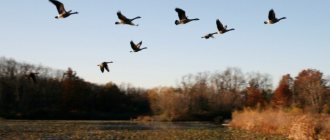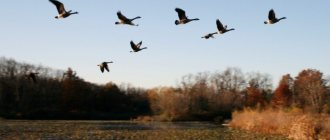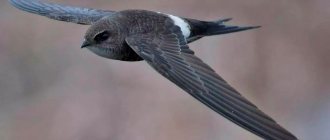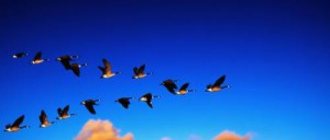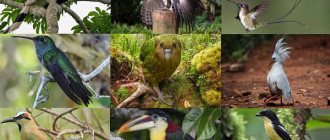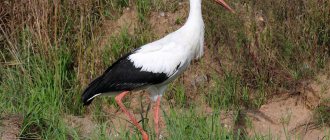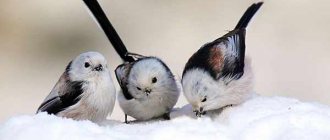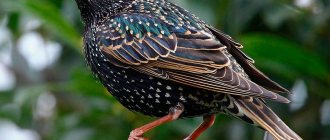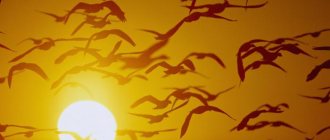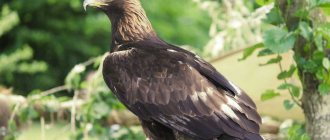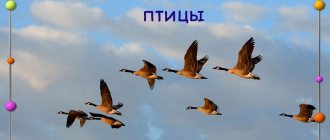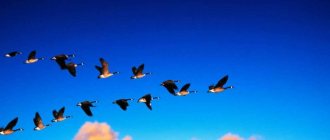Spring arrival of birds
The onset of spring entails significant changes in the bird population of our gardens, forests and fields.
With the appearance of the first thawed patches and until the middle or end of May, one after another, our migratory birds, which spent the winter in more southern regions, return to their homeland. Since their arrival takes place in a certain sequence and lasts for two whole months, an attentive observer, who has already taken a closer look at the birds that winter with us, in the spring can gradually replenish and expand his acquaintance with the world of birds, as they appear in our area; therefore, the end of winter and spring create the most favorable conditions for studying our birds.
The first of the migratory birds to return to us are rooks, appearing in the central zone of the USSR around mid-March, when the ground is freed from snow cover in places and rooks have the opportunity to dig into it with a large and strong beak in search of worms, larvae, slugs and plant seeds. About a week later and second in line, the starling comes to us - one of the most useful birds, destroying many harmful insects and their larvae.
At the beginning of April, skylarks arrive and begin to feed in the thawed areas with last year's seeds of various herbaceous plants. Soon they are followed by siskins, and then finches and linnets. The appearance of finches is easy to observe in the city: the chaffinch is a noticeable (slightly larger than a sparrow) and beautiful bird with a reddish throat, gradually turning into a lilac shade of the chest, and with two wide and sharp stripes on the wings, settling not only in forests, but also in gardens and on the city boulevards and enlivens them with her melodic song with a characteristic flourish at the end.
This song (which can be roughly translated as “chiv-chiv-chiv-chiv-chav-chav-chav-chav-chav-chi-chew”) serves as a characteristic sign of a fully established spring, when all the birds that find feed themselves on the surface of the earth, which has just been freed from snow cover. Most often these are granivorous birds, but only the larger ones, with a long and strong beak (rooks, starlings), are able to rummage in the ground and extract slugs, worms and insects from there.
We do not yet have birds that feed on crawling and flying insects in the first period of spring - at this time they could not yet find food for themselves. Of the insectivorous birds, the earliest to appear are the white wagtails, easily recognizable by their long tail, which they swing up and down at every stop; They arrive by the time when flies and other overwintered insects, which constitute the wagtail’s only food, are already basking in the sun, having awakened from winter torpor.
Soon after the appearance of white wagtails, the so-called gross arrival of birds begins, which in our country occurs in the middle and end of April and the beginning of May; At this time, blackbirds (several species), robins, redstarts, ducks, geese, cranes, gulls, waders, snipes, snipe, woodcocks and many others, mainly wading and waterfowl, fly to us.
Insectivorous birds (at this time there are still a few: the world of insects in April still provides too little prey, especially for birds, which, due to their body structure, cannot scour trunks and branches or dig in the ground, but must grab insects on the fly.
These birds - swifts, swallows (Fig. 232), nightjars, warblers, bluethroats, cuckoos, nightingales, flycatchers, warblers, orioles, warblers and others - arrive only in the last period of spring - from early May to mid-June, that is, during the time when spring finally comes into its own and insects appear in abundance.
order of arrival, which bird arrives first
Content
Nature has designed the way of life of birds in such a way that many of them constantly migrate from one habitat to another, and this happens due to changing weather conditions. Since the temperature regime greatly affects the life activity and reproduction of birds, they usually leave their native lands when winter comes, and return back in the spring, in March-May.
The arrival of birds after wintering always means one thing: the cold has receded and made way for warmth. And here many people become interested in finding out which birds arrive first in the spring.
Which birds arrive first?
Many people do not even suspect that all migratory birds follow a certain arrival schedule, and each species strictly follows it. It is also interesting that they all return to their previous place of residence and even to their previously built nests. If something happened to the nest during the absence of the feathered owners, then the latter settle down anew, after which they breed offspring in them.
So, in what order do spring birds arrive:
- It is believed that wagtails are the first harbingers of the onset of spring, and their cute purring can be heard already with the first melting snow. Wagtails can also often be observed swimming on ice floes;
- Another bright representative of the spring period are rooks, which, like wagtails, return to their domain as soon as the snow begins to melt. These birds first begin active restoration and improvement of their nests, then lay eggs and hatch chicks;
- followed by larks and starlings. Larks notify the entire area about the arrival of warmth with their ringing singing, while starlings hastily begin to arrange their nests, and it is the males who do this, and they are the ones who arrive first than the females. Female starlings arrive a little later and immediately begin laying eggs;
- After everyone else, a finch flies in, a very beautiful bird with a bright appearance: a blue head, a black forehead, a breast, neck and cheeks colored reddish-brown, a back reddish, the finch’s wings yellow at the edges and gray-black inside, and the tail is green;
- behind the finch comes the thrush, a songbird that arouses much admiration among nature lovers. Blackbirds come in a variety of colors, from speckled brown to deep black. Blackbirds begin to sing their iridescent songs, notifying people of the arrival of spring and attracting females;
- in April, redstarts return to their native lands. These are small birds, they are even slightly smaller in size than a sparrow, the color of the plumage is gray with a bluish tint.
What other birds arrive in spring?
Speaking about spring feathered messengers, we should not forget about such
as the nightingale and swallow .
First, it’s worth talking about nightingales, because these are the ones that are recognizable by how wonderfully they can sing. And despite its very inconspicuous appearance (this bird is gray with a brownish tint), the nightingale has a charming voice that fascinates everyone without exception.
Another bright symbol of spring is swallows. These birds cannot sing like nightingales, but they love to settle closer to people, often setting up their nests in the entryways, under balconies and eaves of houses. They can also often be seen in gorges above rivers.
Arrival calendar of spring birds
For many, many years, people have been watching the arrival of birds from the warm regions of their native places, and ornithologists, thanks to scientific research, have been able to create a calendar of arrivals of birds:
- from March 18 to 20, rooks return;
- March 25-April 6—starlings arrive;
- April 1-10—finches, larks, swans and thrushes arrive during this period;
- April 11-20 - ducks and geese, cranes and seagulls return to their native lands;
- end of April - redstarts, tree pipits, chiffchaffs;
- first half of May - swallows and flycatchers arrive;
- in mid-May, swifts and nightingales usually return;
- the orioles return at the end of May.
In addition to certain periods of time during which birds return to their native lands, there are also certain routes along which they travel.
Interesting signs associated with the arrival of birds in spring
The arrival of spring birds is always a sign that winter has receded and spring and warm weather are ahead. And for a long time their certain behavior has been associated with certain signs, for example:
- the bird builds a nest closer to the sun - summer will be cool;
- migratory birds circle in the sky in dense flocks - spring weather will be favorable;
- have the birds become ruffled? This means that we need to expect changes in the weather;
- if rooks circle in flocks around their nests, it means bad weather;
- the nightingale sings all night - it will rain;
- good luck and blessings await you in a house under the roof of which swallows have settled;
- if swallows fly low, it means it will rain;
- the larks arrived early - for a warm spring;
- If migratory birds do not rush to the south in the fall, it means that the warmth will linger.
It is with the melting of snow and the cheerful whistling of birds that the arrival of spring is marked . Schoolchildren begin making birdhouses during craft lessons, and the first swallow's nests begin to appear under the roofs of houses.
zveri.guru
Migratory birds in spring
Oh, how nice it is in the forest! Smells like spring. The snow is melting, the first insects appear. Trills, chirping and birdsong can be heard. After all, the birds that flew to warmer regions in the fall return to their homeland. They enjoy the warmth and sunshine.
Rooks are among the first to arrive. This usually happens in March.
In the old days they said: “If you see a rook, welcome spring!”
The rook is a large black bird with a purple tint. It looks like a carrion crow, but the rook's beak is lighter and the skin around the beak is devoid of feathers. The rook can be up to fifty centimeters in length. Rooks usually live in large colonies, with several dozen nests on one tree.
Which birds are the first to arrive from the south?
March brings early thaws to central Russia, and in some places the snow cover begins to melt.
But the time when spring will take full control of the earth is still far away. In mid-March, the first birds return from wintering grounds; they arrive with the spring wind, delighting people with their appearance. Rooks return to their homeland after a long winter, starting in the second half of March. In the folk calendar there is the day of Gerasim the Rooker - March 17. From this time on, the ground begins to thaw, and birds have the opportunity to obtain food by looking for insects.
The rooks immediately begin building nests. Old houses fall into disrepair over the winter, so there is enough work for everyone. Birds can build up to 15 nests on one tree. Rooks carefully prepare places for hatching chicks, constructing them at a height inaccessible to predators.
Rook nests exist for many years, acquiring a bizarre multi-tiered shape. Both parents build houses, and at the end of March or early April the female lays eggs. The chicks are born after 18-22 days, mom and dad feed them for a month.
Mature rooks master the sky gradually, at first not flying far from the nests. They then gather in flocks and travel across the fields in search of more varied food.
The rook is omnivorous; it feeds on insects, grains and small rodents. Birds destroy pests, but sometimes damage crops and vegetable crops. Despite this, everyone forgives the rook, because he is the first spring songster.
Following the rooks, starlings fly in, filling the birdhouses that have been empty since winter with hubbub and life. This happens at the end of March. First, the males arrive and prepare the houses for the arrival of the females, driving out the uninvited guests. Then the females return, and the new family incubates and feeds the offspring.
Then the larks return from their winter quarters. They begin to settle into nesting sites in early April. Then siskins, finches and linnets arrive. The spring sky comes alive, and the air is filled with the joyful singing of flocks of birds.
The mass arrival of feathered inhabitants for the summer occurs in mid-April and early May. Robins, ducks, geese, and cranes return to their summer quarters. Gulls and waders are also returning to their former habitats.
The return of birds from winter quarters makes people happy after long cold weather, gives hope for the best and the feeling that spring will certainly come, followed by a hot summer.
www.kakprosto.ru
Coloring site for children and adults:
The first bird in spring is considered to be the rook. There is a sign according to which the spring arrival of the rook means that the snow will melt in a month. He arrives in March.
The rook has arrived in the spring and is taking an important stroll...
Then, in the spring, everyone’s favorite starlings and larks come to us. These birds also arrive in March.
The starling and lark arrived in the spring
There is also a lapwing bird, which, depending on the region and its latitude, can arrive even in late February - early March.
Then in the spring wagtails, gulls, magpies, redstarts, thrushes, and cranes arrive.
Buntings arrive, ducks and geese occupy lakes and rivers, nightingales fill the forests.
Swallows, swifts, and of course cuckoos, etc. are returning.
We should not forget that nature influences the spring arrival of birds. Those birds that winter not so far away are the first to react to the arrival of early spring.
Everything in nature is reasonable! As soon as the ice on the rivers begins to melt, ducks and geese immediately arrive. Indeed, it would be stupid for them to arrive first, but the reservoir for them is still frozen and not ready.
In spring, ducks return to ponds
Heralds of spring, birds - signs
Birds have always been the heralds of spring. Among the people there are many signs and superstitions, holidays associated with the arrival of birds.
If you see a starling, it means spring is on the porch
The lark flies to the warmth
The goose calls to spring
Arrival of a swallow in the spring, to the imminent thunderstorms
The wagtail is small, and breaks the ice with its tail
Here they are - the first spring birds that fly to us, bringing us spring, warmth and joy on their wings.
We will be grateful to them for this.
Which of these birds, according to popular wisdom, builds its nest on the house where good people live?
Maybe a stork? :)
Nature is beautiful and all birds are good thanks to this site I learned the names of new birds
Here they are - the first spring birds that fly to us, Thanks for the information!?
Nightingales
One of the singing birds in spring is the nightingale. He has a strong voice, and the songs are very varied and consist of many whistles that alternate with crackling and clicking. Thanks to skillful trills, the image of a bird has been associated with poetic and musical skill since ancient times.
There are about 13 known species of nightingales with very different colors and habitats. The ordinary, or oriental, species is colored in gray-brown shades and is very inconspicuous in appearance. It lives in eastern Europe and western Siberia, and winters in Africa. The blue nightingale is colored blue-black and lives in the taiga of Eastern Siberia, the Far East, Sakhalin, China and Japan, and winters in Indochina and Indonesia.
In what order do birds come home?
All migratory birds return to their homeland according to a certain calendar. Each family follows it from year to year, to the day, and strictly flies to the place where it began its journey for the winter.
Birds have a schedule for the sequence of arrivals, according to which you can find out which birds arrive first in the spring. Let's take a closer look.
Wagtails return home as soon as the snow begins to melt. In different areas this period begins from the end of February to March. Sometimes these birds can be seen swimming on drifting ice.
Second in line, but no less early, are the rooks. They arrive in their native places at about the same time as wagtails.
Finches
Finches are small spring birds, about the size of a sparrow. Their males are variegated with a blue head, orange neck and chest, black and white wings and tail. Females are characterized by a brown color.
The finch lives in coniferous and deciduous forests and is found in city parks and gardens. In summer it lives mainly in Eastern Europe and Western Asia, and can temporarily visit the rest of Europe. The winter range of the bird is very narrow. It covers the sea coast of North Africa (Egypt and Libya), as well as the northeastern part of the Arabian Peninsula. Their departure begins in September, and the birds return back in early April.
Other messengers of warmth
Next on the list are larks and starlings. With the arrival of the first ones, the air is filled with their sonorous singing. But the starlings quietly and silently begin to re-equip their nests.
It is interesting that the male starlings always arrive first, and only a week or two later the females.
Next comes a cute little bird - a finch. It is not difficult to recognize him: a blue head with a black forehead, red chest, throat and cheeks. It is often confused with the bullfinch, but the finch has a red back, yellow wings, and a green tail.
Right after the finch the thrush returns home. He evokes much admiration for his songs among those who love to walk in nature. Males begin to sing and build nests, attracting young females.
In mid-spring, redstarts return home. They are similar in size to sparrows, although their color is bluish.
Birds arriving in May
By the end of April, the forest full of foliage welcomes the nightingale into its arms. He delights those around him with his beautiful singing. Although the bird is completely inconspicuous from the outside, not distinguished by its special color, its songs cannot be confused with anything.
The very end of May is marked by the arrival of swallows. These are heat-loving creatures that arrive when the weather in nature is dry and hot. They like to set up their homes near people. Often nesting sites are balconies, rooftops and gorges above rivers. As a rule, swallows build a nest once and return to it every spring.
Signs about birds returning in spring
Since ancient times, there has been a sign: as soon as the birds return home, be sure to wait for warm days.
There are other signs that are passed down from generation to generation:
- if a bird builds a nest high in a tree, the summer will be cold;
- a large flock of migratory birds means a good, friendly spring;
- I saw feathered birds - wait for a change in the weather;
- rooks fly around their houses - expect trouble;
- the starling has arrived - spring has come;
- a swallow has built a nest near the house - to well-being and happiness in the family;
- if a swallow flies close to the ground, it means it will rain;
- The lark has returned quite early - spring and summer will be hot.
What do birds do when they fly to their native lands?
The birds that have returned to us after winter delight everyone with their loud singing. They are young, full of energy and strength, which is why they immediately begin arranging their homes. Thus, rooks first of all begin to actively restore their nests. Change downy bedding, rotted and broken branches, add new dry grass.
Basically, the males arrive first, regardless of the species. They are busy renovating the old house, and if there is no one left in the winter, they build a new one. By singing and screaming, they attract females, after which they lay eggs and begin to feed new young offspring.
Which bird flies away in the spring?
Yes, you were right, they are flying away. If you look at it precisely, the birds that come to us in the spring do not arrive, but fly past us. Depending on the region, birds are rising higher and higher to the north every week, into temperate latitudes. From this we can conclude that, for example, the nightingale, which migrates to North Africa in the fall, flies away from there in the spring to return to its native land.
Often by spring you can see bullfinches leaving their winter places. This is due to the fact that in the spring the breeding season begins, and they have to look for new nesting sites.
If you liked the article, share it with your friends on social networks, comment and like.
When do the swifts arrive?
As you know, swifts are migratory birds. Their life is closely connected with the presence of flying insects in the air. This is why swifts arrive to us quite late (in the middle or end of May), when stable warm weather arrives, favorable for aerial insects.
Interesting materials:
How to apply Oftan Katahrom drops correctly? How to properly store kumys? How to properly store facial oil? How to properly store flax seeds? How to properly store air plasticine? What is the correct name for pantry or pantry? How to properly glue non-woven wallpaper in corners? How to properly apply stickers for looming eyelids? How to properly glue wallpaper from window to door or from door to window? How to paint metal surfaces correctly?
